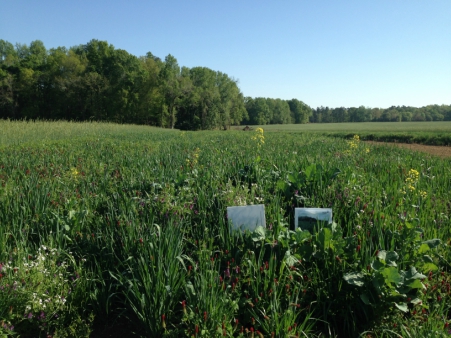When Should I Terminate My Cover Crop?
 There are many interrelated things to consider when deciding when to terminate your cover crop. Obviously, the first is when you need to get your cash crop planted. Another obvious consideration is how wet the soil is and whether you can get through the field without creating a mess.
There are many interrelated things to consider when deciding when to terminate your cover crop. Obviously, the first is when you need to get your cash crop planted. Another obvious consideration is how wet the soil is and whether you can get through the field without creating a mess.
How much biomass the cover crop has produced is also an important consideration. In general, you obtain the most benefit from the cover crop with maximum biomass. However, these benefits need to be balanced with the difficulties that can arise from planting into large amounts of residue—poor cash crop stands will lower yields and more weeds, resulting in economic loss.
Maximal cover crop biomass typically occurs when the cover crop is entering its reproductive stage. In March and April, biomass of winter cover crops, like cereal rye and crimson clover, can double in two to four weeks. There may be circumstances when it is worth delaying planting of the cash crop to take advantage of this burst of cover crop growth. This is particularly true if your goals include maximizing weed suppression in the following cash crop with cover crop residue left on the soil surface or nitrogen fixation by legumes. Research shows you need 8,000-10,000 lbs/ac of cover crop biomass for effective weed suppression. In soybeans that much biomass will not be detrimental to a well-planted crop. However, in corn that much small grain biomass cover crop biomass may lead to increased nitrogen immobilization and potentially, increased seedling disease. Because the amount of available nitrogen provided by a legume cover crop is a product of the amount of biomass and the nitrogen concentration, maximizing biomass also will maximize the potential nitrogen that may be available.
You can choose to plant into green cover crops and terminate while planting, or you can terminate the cover crop and plant at least three weeks later. Some producers like to roll, spray, and plant in one pass to reduce trips across the field. Others like to roll and spray, roll and crimp, or just spray a cover crop to terminate it three weeks to a month before planting. Leaving a three to four week window between termination and planting provides an opportunity for rain to recharge subsoil moisture and reduces the risk of cut worms and other insect pests, seedling-borne diseases, nutrient immobilization, and allelopathy from the cover crops.
More Information:
- A Simple Guide for Conservation Systems in the Southeast. USDA ARS
- Termination of Cover Crops: Management Considerations for the Subsequent Cash Crop. Conservation Systems Fact Sheet No. 11. USDA ARS
Contributors:
Dr. Kip Balkcom, USDA ARS National Soils Dynamic Laboratory; Julia Gaskin, Extension Specialist, University of Georgia; Nathan Lowder, NRCS Soil Health Specialist
